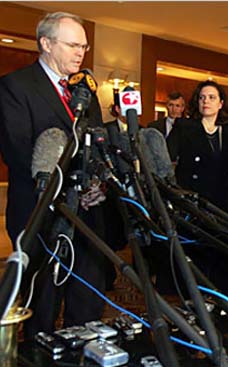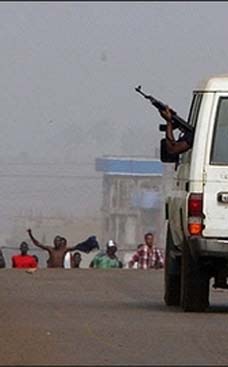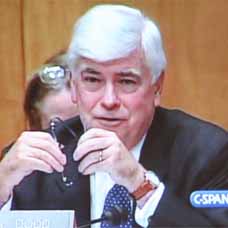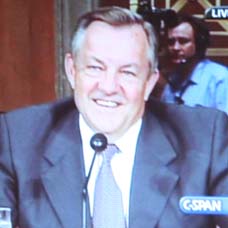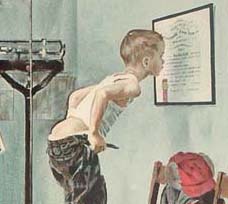
Dyer first became concerned about the low and sporadic water level in the waterways below the dam in the Spring of 1998 and hiked up the mountain to trace the source of the problem. In the process, he trespassed on Pflueger’s land. Pflueger, driving nearby, saw Dyer and graciously offered to drive him up to the Ka Loko reservoir for closer inspection. On this trip, Dyer noted construction with heavy equipment along the edge of the Ka Loko Dam, which fronts the reservoir. Dyer became greatly troubled when he saw the dam’s main safety feature, a concrete spillway about 15 to 20 feet wide located 8 to 10 feet below the dam, was no longer visible, and instead was completely covered by dirt. With a background in engineering, experience in the Peace Corps with earthen dams, and the knowledge he had of Ka Loko as its previous caretaker, Dyer knew right away the serious implication the covering of the spillway had on the dam’s integrity. Too much water in the dam would flow over the top eroding the dam’s structure instead of being guided safely down the spillway. Substantial erosion would mean the dam would not hold. With Ka Loko filling up to as much as 500 million gallons of water, Dyer feared the worst could happen.
Sierra Leone RPCV Mike Dyer was key witness in Kauai's Ka Loko Dam Breach Disaster
Godbey Report: Roadmap to Prevent Kauai's Ka Loko Dam Breach Disaster From Ever Happening Again
Key Witnesses Speak Out for the First Time; Dam's Owner James Pflueger Goes on the Record with Hawaii Reporter; Kauai County Mystery Unsolved; Government on the Hot Seat; Families Still Wait for Justice
By Malia Zimmerman, 1/22/2007 12:51:15 AM
Christina McNees
Caption: Houses on Wailapa Road were shown yesterday amid the muddy damage and debris field from the Ka Loko Reservoir Dam breach
KILAUEA, KAUAI: 22-year-old Christina “Sunny” McNees was captured by a friend on video last March talking about the meaning of life, her belief in God and her future with fiancé, Daniel Arroyo, who she was to marry that weekend. Nearly 9 months pregnant, McNees glowed with excitement as she rubbed her round belly and spoke of the couple’s baby expected within a matter of days. When asked about the meaning of life, she said philosophically: “To remember ... to remember the one-ness and just keep working toward that. And to remember the divine, always, in everybody and everything." Arroyo stood with his arm laced around the shoulder of his bride-to-be and when prompted, shared his inner most thoughts on these subjects.
But for friends and family who flew to Kauai to be with the young couple that weekend, their words about the meaning of life and afterlife are particularly haunting. The young couple did not live to their wedding day or to experience the birth of their baby. Instead, just before the sun rose on March 14, 2006, they were swept away by what witnesses called a “tsunami from the mountain” from their snug guest cottage located near the Wailapa Stream. People of Kauai awoke to the news that on that dark morning, after 44 days of heavy rain, Ka Loko Dam’s 118-year-old earthen foundation gave way, sending more than 400 million gallons of water down what was once a tiny, almost unnoticeable stream.
Witnesses said the wave of water roared by them sounding much like a 747 as it snapped 150-foot trees in the dense Moala forest “like twigs.” They could only get glimpses of what was happening when the electric polls were torn from their stands, lighting up the sky with red flashes. The water that reached as high as 70 feet in some spots, took with its great force everything in its path, including hundreds, if not thousands of trees, homes, 16 cars, boats and irreplaceable ancient Hawaiian historical sites. The beach and reef in the ocean below was severely impacted by debris and sediment. Eight people staying on the Fehring family property lost their lives. Besides McNees, Arroyo and their baby, five other people died, including another young family, Aurora Fehring-Dingwall, her husband Alan Dingwall, and their nearly 2-year-old son, Rowen; the caretaker for the property Wayne Rotstein, and family friend Tim Noonan.
[Excerpt]
Key Witnesses Speak Out
One of the key witnesses interviewed in the Godbey report is Mike Dyer, a well-respected real estate agent on Kauai’s North Shore who in the early 1970s managed Ka Loko Reservoir for then owner C. Brewer. Until now, Dyer has remained silent in the media, only speaking to state investigators.
But in an interview this week with Dyer at his home in Princeville, he told Hawaii Reporter how he’d documented unsafe activity at the dam in the late 1990s and reported it to both the dam’s owner, automobile mogul James Pflueger, and to the state Department of Land and Natural Resources Kauai office. His warnings were never heeded or even acknowledged.
Dyer first became concerned about the low and sporadic water level in the waterways below the dam in the Spring of 1998 and hiked up the mountain to trace the source of the problem. In the process, he trespassed on Pflueger’s land. Pflueger, driving nearby, saw Dyer and graciously offered to drive him up to the Ka Loko reservoir for closer inspection. On this trip, Dyer noted construction with heavy equipment along the edge of the Ka Loko Dam, which fronts the reservoir. Dyer became greatly troubled when he saw the dam’s main safety feature, a concrete spillway about 15 to 20 feet wide located 8 to 10 feet below the dam, was no longer visible, and instead was completely covered by dirt. With a background in engineering, experience in the Peace Corps with earthen dams, and the knowledge he had of Ka Loko as its previous caretaker, Dyer knew right away the serious implication the covering of the spillway had on the dam’s integrity. Too much water in the dam would flow over the top eroding the dam’s structure instead of being guided safely down the spillway. Substantial erosion would mean the dam would not hold. With Ka Loko filling up to as much as 500 million gallons of water, Dyer feared the worst could happen.
Dyer did not keep his concerns to himself. With Pflueger’s permission, Dyer returned to the dam for closer inspection with his wife and took pictures of the covered spillway and heavy grading around the dam. Letters and pictures he provided to Hawaii Reporter show he shared his concerns with Pflueger on two occasions.
On May 22, 1998, Dyer wrote to Pflueger: “I have a question about the spillway out of Ka Loko into Morita Reservoir. Please call me.” When Pflueger did not respond, Dyer wrote again on June 4, 1998: “It looks to me as if the Ka Loko spillway is covered with 8 to 10 feet of new fill. The reservoir is about 1 to 2 feet above the old fill level. It would probably take at least several months for Ka loko to fill to the new level. Then I think water will flow over a broad area in the middle of your earth dam ... just an eyeball guess. I suggest you consider digging back down to the old concrete spillway, setting a small culvert on the spillway and then backfilling it to your current level. You would probably also need to cut a new overflow ditch to the valley below your dam. Your building sites are beautiful. Thanks for letting [my wife] and me hike up there.”
Pflueger never responded to either letter, according to Dyer. Increasingly troubled, Dyer took his documents to the state Department of Land and Natural Resources and made a report, which that department claims is not in its files. But Dyer is sure the state received it because after his complaint was filed, Pflueger called him up and accused him of “turning him into the state.” Dyer said Pflueger said to him in a threatening manner during that call: “You better not have.”
Did Dyer do enough to prevent this disaster? He doesn’t think so. He glanced at his wife with pain in his eyes when he talked about the tremendous sorrow and guilt he feels because he did not personally ensure the spillway was restored. Dyer notes he is old friends with the Fehrings and even sold them the family property. He assumed the state would take care of the problem -- because the water level downstream seemed to be restored, he believed the state had done something. But in reality, the personnel in the state Department of Land and Natural Resources, the agency charged under a 1987 state law with inspecting all dams in the state every 5 years to ensure their safety, did nothing. Peter Young, director of this agency since 2002, admits the dam was never inspected and no one responded to Dyer’s complaint.






